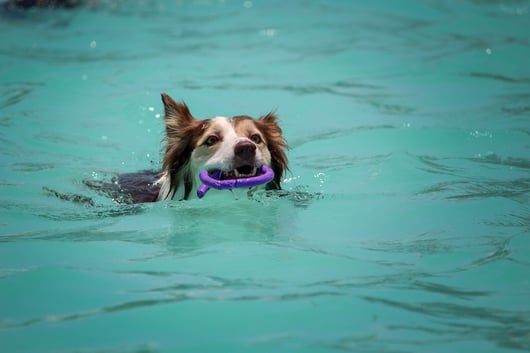3 Tips to Keep Your Pet Cool in the Summer Heat
Updated on: July 28, 2022 | Author: Starwood Pet Travel

Summer heat is delightful in many ways, but there is such a thing as too hot. Pets, just like people, can suffer unnecessarily in the heat, and they also face serious health risks such as heat stroke. Let’s all plan on keeping our cool this summer.
Here are some ways you can help your dog or cat stay cool and comfortable:
1. Understand how their bodies work
We all know that dogs pant to cool themselves. But did you know that cats pant, too? This is an evaporative cooling system, like sweating in humans. As your pet pants, the air evaporates saliva on their tongue. Cats use grooming as a way to cool down, too.
Something else most people don’t know is that cats and dogs also have a few sweat glands between their toes. So one thing you can do is give them a cooling foot bath, or provide a wading pool for overheated paw relief. (Many dogs like to lie in wading pools, too, so be sure the water level is an appropriate for your size pooch.)
One thing to avoid: ice. It may seem like a kindness to ice down your pet or add ice to their water, but that can actually be dangerous because it lowers their temperature too fast. That restricts blood flow, hindering their body’s ability to cool itself.
2. Know the signs of trouble
While you’re playing, look for symptoms of heat stroke such as slowing or fatigue. Panting is an obvious indicator your dog or cat is overheating or becoming dehydrated. The hotter they get, the more they pant, making themselves hotter instead of cooler and increasing their heartbeat and respiration rate. Keep an eye out for:
- Drooling or salivating
- Agitation or restlessness
- Extremely red or pale gums or a very red tongue
- Difficulty breathing
- Vomiting or diarrhea (possibly with blood)
- Appearing confused or dizzy
- Seizures
- Collapsing and lying down
- Little to no urination
In extreme cases of heat stroke, it can lead to death. So even at the beginning signs of distress listed above, get your pet in a cool, shady environment with plenty of water. If you have any concerns, call your veterinarian or take your pet to an emergency vet hospital to be seen.
3. Modify outdoor activities
- Walk your dog and engage in outdoor play in the morning or evening, rather than the hottest part of the day. Hot concrete, asphalt, and sand can burn their pads, so walk where there is grass and stay in the shade if possible. Many merchants and outdoor cafés provide water for dogs, but always carry a bottle of water and portable water dish. Hydration is crucial (for you, too).
- Consider getting a cooling vest for your especially-heat-sensitive dog. Snub-nosed and very short-haired breeds can find the sun and heat more challenging. You may also want to use dog-appropriate sunscreen, particularly on their nose but also on their fur. Ask your vet about this.
- Don’t assume that shearing/shaving your dog or cat is a smart idea. Ask your vet about their recommendations on that, too.
- Never leave your pet in the car, even if the day seems only “warmish” to you. Windows open or not, vehicles turn into ovens in minutes. We all know this, yet every year pets suffer and even die because their bodies cannot fend off this extreme heat. Leave them home if you have to make pit-stops that don't involve bringing your pet with you.
- At home, make sure pets have plenty of fresh water, indoors and out, as well as a shady, cool space to rest outdoors.
Traveling by air this summer? Beware of heat-related travel restrictions
If you’re planning a vacation or long-distance move with your pet, you need to know that airlines around the world do not allow pets to fly when it’s extremely hot. Most airlines use 85o F as their threshold. This policy can be tremendously frustrating, because weather changes from day to day and that can throw the proverbial monkey wrench in your pet’s travel plans.
Nonetheless, you should be grateful, because the point is to protect your pet from undue heat stress as they’re traveling to and from the plane. The trip is usually short, but the tarmac radiates heat.
So your pet may have a reservation, but the airline decides whether animals can fly, based on that day’s predicted temperatures. Weather restrictions apply to every ground location on your pet’s itinerary – the point of departure, the destination and any stops along the way – which is where it can get tricky. Some locations, such as the UAE, are always warm-to-hot, while others fluctuate more throughout the year.
This is one reason why working with a professional pet transport company can be a real life- and sanity-saver. They not only know the best travel routes for your pet, they provide back-up if there is a scheduling delay. You have peace of mind knowing your pet is in the best of hands, and you can focus on your own travel challenges.
Meanwhile, here at home, peace of mind comes from knowing you’re doing everything you can to help your four-legged friend stay cool in the summer heat.
Subscribe to the Blog
Enjoy our content? Get them sent to your inbox!
Subscribe Now!

